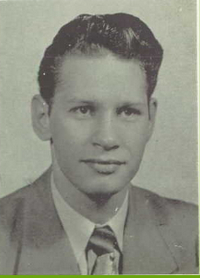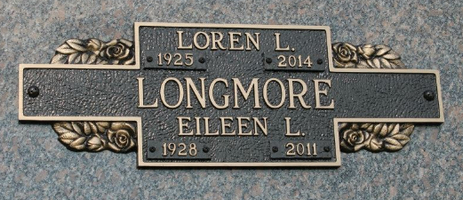Skip to content
Loren "Ike" Lavern Longmore
Jeremy Anderson2020-12-19T14:50:41-06:00
- Name: Loren "Ike" Lavern Longmore
- Location of Birth: Warba, Minnesota
- Date of Birth: August 16, 1925
- Date of Death: December 25, 2014
- Parents: Ernest Longmore & Nellie (Brown) Longmore
- High School and Class: 1943 Greenway High School, Coleraine, Minnesota
- College: 1952 Itasca Junior College, Coleraine, Minnesota
- Highest Rank: SGT (Sergeant)
- Branch: Army
- Other Branch:
- Date Sworn In: October 1943
- Place Sworn In:
- Date of Discharge: April 5, 1946
- Place of Discharge:
-
- Military Awards:
- Military Highlights:
WW II Draft Registration Cards – 10/16/1940 – 03/31/1947
State: Minnesota
Name: Loren Lavern Longmore
Race: White
Age: 18
Birth Date: August 16, 1925
Birth Place: Grand Rapids, Minnesota, USA
Residence Place: Coleraine, Minnesota, USA
Registration Date: August 16, 1943
Employer: Danube Mining Co., Taconite, Minnesota
Weight: 130
Height: 5-5
Complexion: Light
Eye Color: Brown
Hair Color: Brown
Next of Kin: Mrs. Ernest Longmore, Coleraine, Minnesota
Newspaper article: May 1945 – “Word comes from an Eighth Air Force bomber station in England that Loren L. Longmore of Coleraine has been promoted from the grade of Corporal to Sergeant. Sgt. Longmore, radio operator gunner on a B-17 Flying Fortress, received his training at Scott Field, Illinois, Yuma, Arizona, and Rapid City, South Dakota. He entered the Army in October of 1943.”
Newspaper article: May 1945 – “Cpl. Longmore remembers Mother’s Day – “Dear Mother” Tomorrow is Mother’s day so I thought I would write you a letter exclusively. I’ve been flying all day and I’m kinda tired but I guess I can struggle through a letter. I guess I’ve seen more of Europe in the last two days than I ever will again. Now that the war is over our crew, along with the others on the field, have been taking the ground crews over to look at the bomb damage in Europe. Yesterday we flew out of England, over the English Channel and entered the Continent in Belgium. We flew over Brussels Belgium, Essen Germany, Cologne, Frankfurt, Schweinfurt, Manheim, Ludwigshafen, Koblenz, Aachen, Germany, and Reims and Paris France. They were two of the most interesting flights I imagine I will ever fly. The German cities of Cologne, Koblenz, Schweinfurt, Frankfurt, and Aachen were the hardest hit I think. It is almost unbelievable the complete devastation all over Germany. The cities I mentioned are completely wiped out. That is about the only way I can describe it. We flew over sometimes as low as 150 feet and had a perfect view of the ruins. As our bombers went over, the small children would scatter in all directions. We were so low we could almost see the expressions on their faces. Even though the war is over, the memory of the bombing remains. We went about 500 miles into the continent of Europe and all the way we could see trenches and shell craters in the farmer’s fields. I remember the city of Cologne especially. The whole city was completely demolished. Actually every building in the city was either bombed, shelled or burnt. The striking thing was that every building in the whole city (about the size of Minneapolis) was chalk-white as if burnt white. There is only one building left in the city and that is a mammoth cathedral. It is coal black and stands like a monument to God among all the bleakness about it and as far as I could see it was completely untouched. I have seen churches standing untouched among the ruins of other cities but none stood out as much as that beautiful cathedral in Cologne. Germany is the most beautiful country I have ever flown over, though France is very beautiful also. We saw the old windmills they have here and also one of the medieval castles with a moat surrounding it. It looked exactly as they did in the fairy tales at school. We saw graveyards where the war dead were buried. There must have been thousands of graves there. When we came back today we flew over Paris. Paris was never touched and is the most beautiful city in the world. We flew over the Arc de Triomphe and Eiffel tower, so close I felt I could reach out and touch them. There was also a big statue or something or other but I don’t know what. It gives you a feeling of awe when you fly over Paris. I imagine it’s because it has such a history. Well, the ground crew enjoyed it and I’m glad they did because they really have done their part in this war and got very little credit. I guess I had better close this now. I don’t know what the censor will do to it. They told us we could write about our ‘Rubberneck’ missions, as we call them, so I guess it’s O.K. How is everybody at home? Fine I hope. I am very well and to be frank, I really ‘never had it better’ since I’ve been in the army. I get paid tomorrow. There are only ten men in my barracks and we are one big happy family. We have an electric stove and now and then we cook up a meal fit for a king, fried chicken and all. We’ve got a radio. And the army has set up a radio program over here where you get music steady day and night. I think I’ve heard every song I ever knew since I’ve been here. How did they take the news of surrender over there? They tell me London was a bedlam. Bands were playing and flags were selling for a pound ($4.00) a piece. All the towns all over England flew flags of all shapes and descriptions. Well, Mother, I tried to make this letter as interesting and as long as possible because that’s about all I can do for Mother’s Day. Hope you receive flowers from me in person next Mother’s Day. I must close now. Good night. Love, Loren.”
Newspaper article: May 1945 – “ENGLAND, V-E DAY – Among the 185,000 men and women of the Eighth Air Force congratulated today by Lt. Gen. James E. Doolittle, who assumed command of the Eighth in January 1943, is Sergeant Loren L. Longmore and Sgt. Keith Goulet of Coleraine, Minnesota. The following is a copy of the congratulations received by the two men: “I wish to extend my personal congratulations and my heartfelt appreciation to every one of you for the magnificent job you have done,” Gen Doolittle said in a message to all personnel. “Each of you,” he continued, “may be proud of your part in the defeat of Germany. I am proud of you. The world is proud of you.” The Eighth Air Force was the world’s mightiest strategic bombing force. Its personnel of 185,000 was the equivalent of 12 infantry divisions, and it could send 21,000 airmen in 2,000 four-engine bombers and 1,000 fighters over Germany at one time, a combat effort possible only through the support of tens of thousands of non-flying specialists. Since August 1942, when combat operations began, Flying Fortresses and Liberators of the Eighth dropped more than 700,000 tons of bombs on enemy targets. Fighter pilots shot down 5,250 Nazi planes and destroyed 4,250 others on the ground. Bomber gunners shot 6,000 German interceptors out of the air. The Eighth dropped an average of a ton of bombs every minute of the last 12 months. Airmen of the Eighth were the first Americans to attack Germany. The early crews flew a handful of unescorted bombers against the powerful Luftwaffe, and proved the feasibility of an American idea – precision daylight bombing over the Reich. As the Eighth grew in strength, it was assigned the task of crushing the German Air Force, which had to be done before the allies could invade France. Bombers of the Eighth smashed Nazi aircraft production centers. Its fighters destroyed thousands of enemy planes in the air and on the ground. After beating the Luftwaffe into relative impotency, the Eighth threw its growing weight against Germany’s rail system and vital sources of oil. These campaigns, in conjunction with the British Royal Air Force and the U.S. 15th Air Force, disorganized all transport in Germany, restricted German military operations in the air and on the ground and paved the way for the march of Allied armies across Europe.”
- Wars Involved:
World War II
- MIA / POW:
- Civilian Life:
Loren Longmore returned to northern Minnesota after his discharge from service. He married Eileen Hendrickson in 1950 in Minnesota. He completed his degree in physical therapy in Minneapolis, Minnesota. The family moved to Neenah, Wisconsin, then Green Bay, and finally settling in Marshfield. He started the physical therapy department at St. Joseph’s Hospital there and then began an independent physical therapy service, Theracare, Inc., in 1976. He continued with that service until his retirement in 1988. After retirement, Loren and Eileen spent summers in northern Minnesota and winters in Harlingen, Texas. They traveled east to connect with Loren’s WW II bomber crew in the spring.
Loren died in Harlingen, Texas, following a bicycle accident, and his remains are buried in McMillan Memorial Gardens, Marshfield, Wisconsin. He is survived by his children: Carol (Jack) Braford, Valeri Gungor, Jeffrey Longmore, Gary Longmore, and Kevin Longmore; several grandchildren; and two sisters, Bonnie Jaeger and Alice Kochaver. He was preceded in death by his wife, Eileen; his special friend, Janice Crotteau; his parents, Ernest & Nellie Longmore; and sisters, Lois Berg, Arla Nelson, Wilma Tobeck, and Merla White.
- Tribal Affiliation(s):
Page load link




